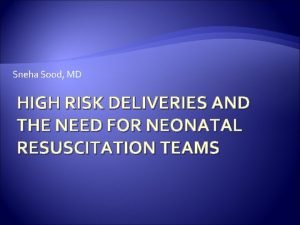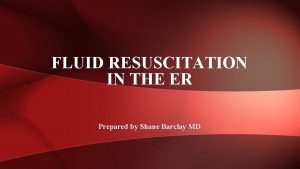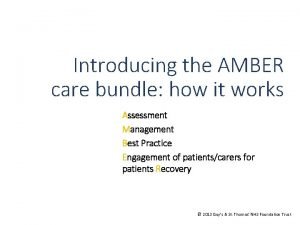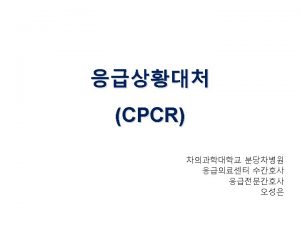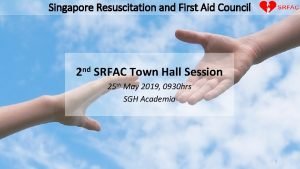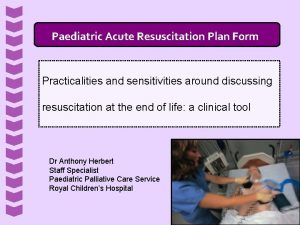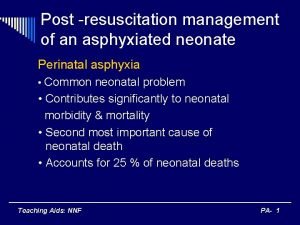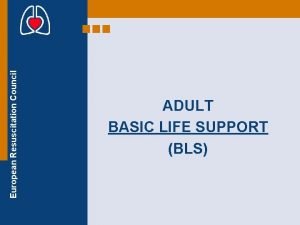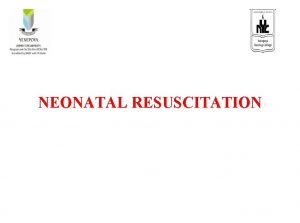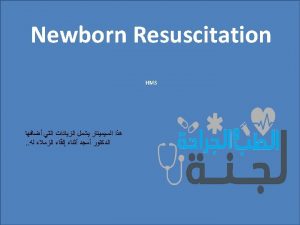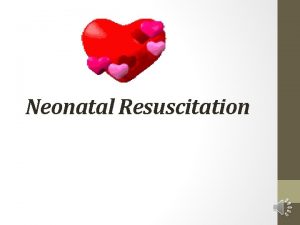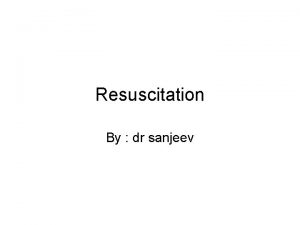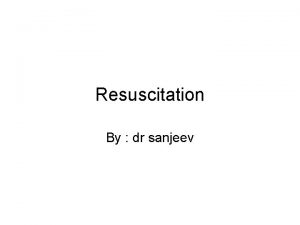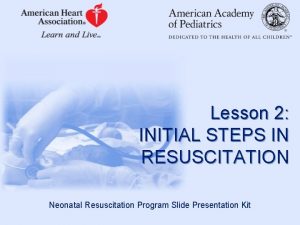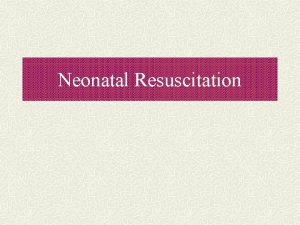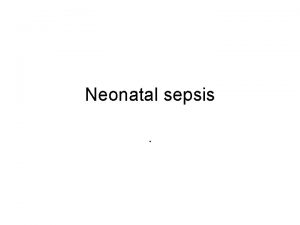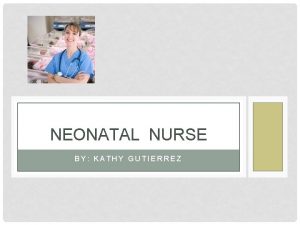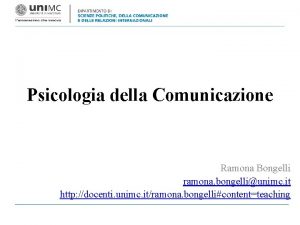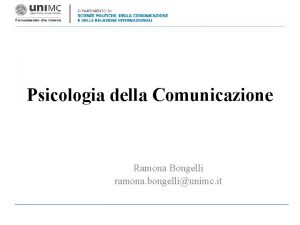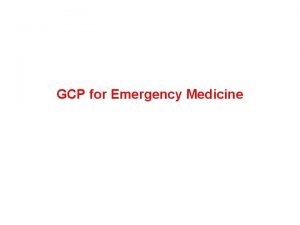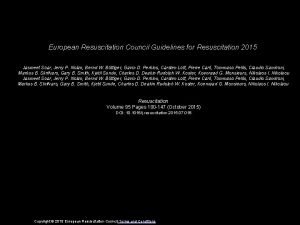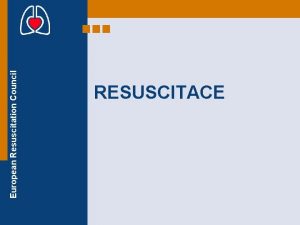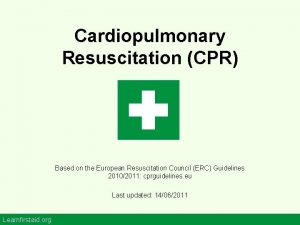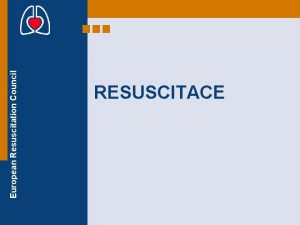NEONATAL RESUSCITATION Ramona Sunderwirth MD Pediatrics Emergency Medicine
































- Slides: 32

NEONATAL RESUSCITATION Ramona Sunderwirth, MD Pediatrics Emergency Medicine Mt Sinai St Luke’s Hospital Medical Center New York, NY

Neo Natal Resuscitation Course Foundations Preparing for Resuscitation Initial Steps of Newborn Care Positive Pressure Ventilation Alternative Airways: endotracheal tubes and Laryngeal masks Chest Compressions Medications Post resuscitation Care Resuscitation /Stabilization of Preterm babies Special considerations Skills Practice Case scenarios

Foundations of NN Resuscitation Why NN resuscitation skills are important Physiologic changes that occur during and after birth Format of the Neonatal Resuscitation Program Flow Diagram Communication and teamwork skills used by effective resuscitation teams

Why do newborns require a different approach to resuscitation than adults? Adults requiring resuscitation � Trauma � Existing heart disease � CAB (Circulation, Airway, Breathing)

Why do newborns require a different approach to resuscitation than adults? Newborns requiring resuscitation � Respiratory problems leading to inadequate gas exchange � Respiratory � ABC failure (Airway, Breathing, Circulation)

Fetal Circulation

Neo. Natal Respiratory Failure Before Birth � Early and late stages of respiratory failure After Birth � Early or late? � Baby does not initiate of cannot maintain effective breathing effort

Neo. Natal Resuscitation Focus Establishing effective VENTILATION Single MOST IMPORTANT concept

What happens during the transition from fetal to neonatal circulation? The baby is born, breathes, cord clamped Baby now uses lungs, not the placenta, for gas exchange Fluid in the lungs is absorbed � Air replaces fluid in alveoli, � O 2 moves from alveoli into pulmonary blood vessels � CO 2 moves into alveoli and is exhaled Air in alveoli causes blood vessels in the lung to dilate � Pulmonary blood flood increases

Baby’s cries move fluid out of alveoli

Pulmonary Vessels dilate

New Born Circulation

Review Before birth, the alveoli in the fetal lungs are expanded and filled with (fluid)/(air) Before birth, O 2 is supplied to the fetus by the (the placenta)/(the fetal lungs) After birth, air in the alveoli causes vessels in the baby’s lungs to (constrict)/(relax)

Answers Before birth, the alveoli in the fetal lungs are expanded and filled with (fluid)/(air) Before birth, O 2 is supplied to the fetus by the (the placenta)/(the fetal lungs). After birth, air in the alveoli causes vessels in the baby’s lungs to (constrict)/(relax)

How does newborn respond to an interruption in normal transition? Irregular, or rapid breathing or apnea Slow heart rate or rapid heart rate Decreased muscle tone Low oxygen saturation


Communication and Team Work

Communication and Teamwork Focus on teamwork � Poor teamwork and communication are causes for preventable infant deaths in the delivery room � During complex resuscitation, providers need to perform multiple procedures without delay

Pre resuscitation team briefing Each team member need to understand roles and tasks Before each birth, review the clinical situation and action plan Assess perinatal risk factors, identify team leader, delegate tasks, determine what supplies and equipment needed, identify how to call for additional help

The Team Leader Good communication skills Situational awareness: aware of the “big picture” If team member changes during resuscitation, a clear verbal statement made so all team members know who team member is

Effective communication Every team member shares responsibility for resuscitation Share information and communicate with each other

Closed Loop Communication Technique � Ensures instructions are heard and understood � When you give an instruction, direct the request to a specific individual, call them by their name, make eye contact and speak clearly � After giving instruction, ask the receiver to report back as soon as the tack is completed � After receiving an instruction, repeat the instruction back to the sender.

Team Members Leader Airway Chest compressions Umbilical Vein/Intraosseous/IV access Recording/Documentation Medications

Post resuscitation team debriefing Reinforces good teamwork habits, identifies areas for improvement May identify major problems or small changes that results in improvements in team performance

NN Key Behavioral Skills - 10 1 – Know your environment � Perform equipment check before baby delivered � Know the location of resuscitation equipment � Know how to call for help and who is available

Behavioral Skills cont 2 – Use available information � Know the prenatal and intrapartum history 3 – Anticipate and plan � Pre resuscitation team briefing � Assign roles and responsibilities � Discuss an action plan in the event of complications

Behavioral Skills - cont 4 – clearly identify a team leader � Identify the team leader before the birth � Effective leaders

Behavioral skills - cont 5 – Communicate effectively � Call team members by name � Share information actively � Inform your team if you identify a problem � Order medications by name, dose, and route � Use concise, clear language � Use closed-loop communication � Ensure that changes in information/assessments are shared � Include family members in communication as appropriate

Behavioral Skills - cont 6 – Delegate workload � Do not allow on person to become overloaded with tasks 7 - Allocate attention wisely � Maintain situational awareness

Behavioral Skills - cont 8 – Use available resources � Know what personnel are available � Know what additional or special supplies are available/how to assess them 9 – Call for additional help when needed � Anticipate need for additional team members

Behavioral Skills - last 10 – Maintain professional behavior � Use respectful verbal and nonverbal communication � Seek and offer assistance � Support and promote teamwork � Respect and value your team

Key Points Some NB require resuscitation, including assisted ventilation NB resuscitation is usually the result of respiratory failure, either before or after birth The most important and effective action in NB resuscitation is to VENTILATE the baby’s lungs Very few NB require chest compressions or medications Resuscitation should proceed quickly, efficiently Teamwork, leadership, communication: critical to
 Apgar
Apgar Site:slidetodoc.com
Site:slidetodoc.com Neonatal resuscitation definition
Neonatal resuscitation definition Preterm classification
Preterm classification Indication for exploratory laparotomy
Indication for exploratory laparotomy Dutch north sea emergency medicine conference
Dutch north sea emergency medicine conference University of new mexico internal medicine residency
University of new mexico internal medicine residency Elizabeth kuson
Elizabeth kuson University of arizona emergency medicine
University of arizona emergency medicine Emergency medicine case presentation
Emergency medicine case presentation Difference between resuscitation and resurrection
Difference between resuscitation and resurrection Chapter 17 providing first aid
Chapter 17 providing first aid Endpoint of resuscitation
Endpoint of resuscitation Amber care meaning
Amber care meaning Components of high quality cpr
Components of high quality cpr Resuscitation cpr
Resuscitation cpr National resuscitation council singapore
National resuscitation council singapore Introduction to cpr
Introduction to cpr Broselow tape
Broselow tape Mount vernon formula
Mount vernon formula European resuscitation council
European resuscitation council Acute resuscitation plan
Acute resuscitation plan Management of asphyxia neonatorum after resuscitation
Management of asphyxia neonatorum after resuscitation Principles of resuscitation
Principles of resuscitation Bls
Bls Resuscitation of newborn procedure
Resuscitation of newborn procedure Cardioprotection resuscitation
Cardioprotection resuscitation European resuscitation council
European resuscitation council Ramona polmane
Ramona polmane Ramona quimby age 8 lesson plans
Ramona quimby age 8 lesson plans Ramona bologa ase
Ramona bologa ase Nancy staggers
Nancy staggers Ramona reynolds
Ramona reynolds


